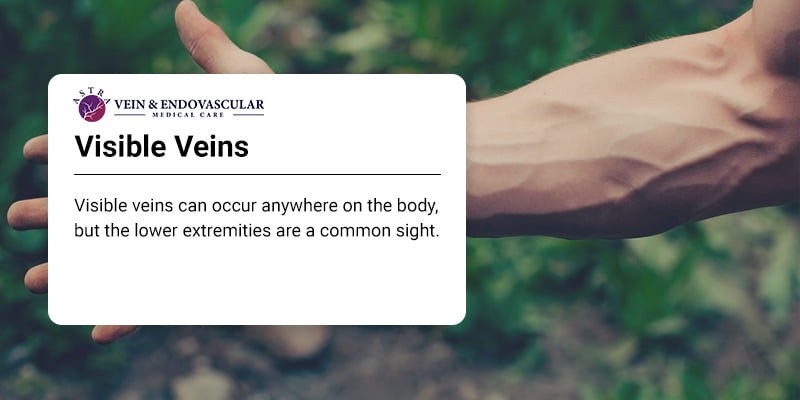Noticing veins showing through your skin or bulging out can be alarming. While prominent veins are sometimes a normal occurrence linked to factors like a healthy Body Mass Index (BMI), regular physical activity, or even warm weather, it’s crucial to understand when they might indicate a more serious health concern. Painful or unusually visible veins should never be ignored. These symptoms can be signs of underlying health issues that require professional evaluation to prevent potential long-term complications. If you’re concerned about your veins, consulting a vein specialist is a vital step towards ensuring your vascular health.
If you’ve observed that the veins in your legs are becoming increasingly noticeable, appearing darker, or feeling raised, it’s important to pay attention. Monitor for additional symptoms such as leg swelling, a sensation of heaviness, aching, itching, tingling, cramps, skin discoloration, or even ulcers. While there can be benign reasons for visible veins, they can also be an indicator of an underlying vein disease.
Vein diseases often arise when the tiny valves within leg veins malfunction, hindering their ability to efficiently pump blood back to the heart. This malfunction leads to blood pooling in the veins, potentially resulting in conditions like varicose veins, spider veins, restless leg syndrome, and other significant health problems. Varicose veins, in particular, increase the risk of blood clots and venous ulcers, making it essential to address them promptly.
What Contributes to Vein Visibility?
Visible veins can appear across the body, but they are commonly observed in the legs and lower extremities. If your veins are protruding due to factors like consistent exercise, low body fat, and well-developed muscle, it’s often not a cause for concern. However, if visible veins are accompanied by pain or other troubling symptoms, they could signal an underlying health issue.
Several factors play a role in both vein health and their visibility. These include:
- Genetics
- Lifestyle choices
- Environmental factors
Gaining a deeper understanding of vein health can provide valuable insights into the reasons behind why your veins are becoming more prominent.
Common Causes of Prominent Veins
There are various reasons why your veins might become more visible. These can range from lifestyle factors to physiological changes:
- Exercise: Visible veins during exercise are often a positive sign, indicating an efficient cardiovascular system at work. Weightlifting, in particular, can lead to bulging veins, especially in individuals with a lower BMI.
- Skin Tone: People with fair skin and lighter hair are naturally more likely to have veins that are visible through the skin due to less pigmentation.
- Age: As we age, our skin naturally thins, making underlying veins more apparent. Additionally, age-related loss of body fat can make veins closer to the surface and thus more noticeable.
- Obesity: Excess weight puts additional pressure on your veins. This added strain can cause veins to become more prominent and visible.
- Family History: Genetics play a significant role in vein health. If visible veins run in your family, you have an increased likelihood of developing them yourself.
- Hormonal Fluctuations: Hormonal shifts can significantly impact vein health. Imbalances caused by pregnancy, menopause, or other conditions can contribute to visible veins. During pregnancy, increased blood volume expands blood vessels, often leading to more prominent veins. While this often resolves after childbirth, persistent visible veins may require medical evaluation.
- Weather Conditions: Veins tend to be more visible during warmer months. Heat can cause veins to dilate (enlarge), forcing the vascular system to work harder, which can make veins appear more prominent.
- Prolonged Inactivity: Extended periods of sitting or standing can contribute to visible veins, as gravity affects blood flow and can cause pooling in the legs.
If your prominent veins are due to any of these common reasons, it’s still wise to be aware and monitor them. However, if you suspect there might be another underlying cause, seeking advice from a vein specialist is crucial. They can accurately determine the reasons behind your vein appearance and recommend appropriate next steps.
When Visible Veins Are a Sign of a Medical Condition
While some causes of visible veins are benign, others can indicate underlying medical conditions that require attention. It’s important to be aware of these potential issues:
Conditions associated with visible veins include:
- Spider Veins: These are small, web-like veins that appear blue, green, or purple, typically on the legs and face. They arise due to poor circulation and manifest as discolored, visible veins in a spider web pattern.
- Varicose Veins: Varicose veins are characterized by their enlarged, twisted, and bulging appearance, rising above the skin’s surface. Untreated varicose veins can cause considerable pain and discomfort, including leg heaviness, swelling, itching, and burning sensations. They are often a result of underlying vein disease or chronic venous insufficiency.
- Blood Clots: Visible veins can sometimes be associated with or develop into blood clots, a potentially life-threatening condition if not promptly treated. A clot can break loose and travel to the lungs, causing a pulmonary embolism. Two primary types of blood clots are Superficial Thrombophlebitis (ST) and Deep Vein Thrombosis (DVT). Symptoms often include leg pain, redness, swelling, tenderness, warmth, and cramping, usually in one leg.
- Skin Changes Indicating Vein Disease: Pay attention to skin changes, as they can be indicators of vein disease and lead to serious skin problems. These changes can include discoloration, itching, burning, rashes, and venous ulcers. Venous ulcers are open sores on the legs, often near varicose veins, that are slow to heal or don’t heal at all. They are a sign of advanced vein disease and increase the risk of skin and blood infections.
Treatment Options for Visible Veins
If you’re bothered by the appearance of your visible veins or experiencing discomfort from conditions like varicose veins, minimally invasive treatments are available to help you achieve healthier veins and legs.
Scheduling a consultation with a vein specialist is the first step to understanding why your veins are prominent and what can be done to improve their condition. Vein diseases require accurate diagnosis and assessment by a qualified vein doctor.
Experienced vein specialists utilize advanced diagnostic equipment and a comprehensive approach to treat malfunctioning veins, redirecting blood flow to healthy veins. Many treatments are quick, often completed within 15 to 30 minutes, allowing you to return to your normal activities shortly after.
Treatment options for visible veins include:
- Endovenous Laser Treatment (EVLT): This procedure uses laser energy delivered through a small fiber catheter inserted into the vein via tiny incisions. Guided by ultrasound, the laser heats and closes off the diseased vein. EVLT is effective for treating varicose veins of various sizes, particularly those close to the skin surface.
- ClariVein: ClariVein offers a treatment for varicose and spider veins that doesn’t rely on laser energy. This catheter-based method combines mechanical and chemical actions to treat damaged veins.
- Varithena: Varithena is a foam-based treatment specifically designed for diseased veins. It’s used to collapse varicose veins within the Great Saphenous Vein (GSV) and surrounding areas.
- Ultrasound-Guided Sclerotherapy: This procedure uses ultrasound imaging to guide the injection of a sclerosant solution into affected veins. The solution irritates the vein walls, causing them to collapse and seal shut. The treated vein tissue is then naturally absorbed by the body.
- Visual Sclerotherapy: Similar to ultrasound-guided sclerotherapy, visual sclerotherapy uses sclerosant injections to treat spider veins located near the skin’s surface. It is known for minimal side effects.
A vein specialist will assess your specific condition, the visibility of your veins, and any accompanying symptoms to create a personalized treatment plan. Dr. George Bolotin at Astra Vein Treatment Center specializes in the treatment of prominent veins. He offers thorough vein evaluations and utilizes ultrasound diagnostics to accurately diagnose your condition and provide effective relief. Taking proactive steps to understand and address your vein health can help you avoid more serious vein issues in the future.
Vein & Vascular Medical Care
4209 Ave U, Suite A. Brooklyn, NY 11234
(718) 222-0225
Updated on Nov 4, 2024 by Dr. George Bolotin (Vein & Vascular Specialist) of Vein & Vascular Medical Care

